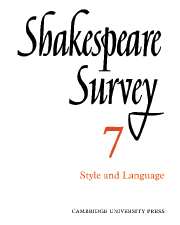Book contents
- Frontmatter
- Fifty Years of the Criticism of Shakespeare’s Style: A Retrospect
- Shakespeare and Elizabethan English
- The Poet and the Player
- Shakespeare’s Orthography in Venus and Adonis and Some Early Quartos
- The New Way with Shakespeare’s Texts: An Introduction for Lay Readers. I. The Foundations
- The Red Bull Company and the Importunate Widow
- Vaulting the Rails
- Shakespeare and the Acting of Edward Alleyn
- The Birmingham Shakespeare Memorial Library
- Shakespeare’s Italy
- International Notes
- Shakespeare Productions in the United Kingdom: 1952
- Acting Shakespeare: Modern Tendencies in Playing and Production
- The Year's Contributions to Shakespearian Study 1 Critical Studies
- 2 Shakespeare’s Life, Times and Stage
- 3 Textual Studies
- Books Received
- Index
- Plate Section
The Poet and the Player
Published online by Cambridge University Press: 28 March 2007
- Frontmatter
- Fifty Years of the Criticism of Shakespeare’s Style: A Retrospect
- Shakespeare and Elizabethan English
- The Poet and the Player
- Shakespeare’s Orthography in Venus and Adonis and Some Early Quartos
- The New Way with Shakespeare’s Texts: An Introduction for Lay Readers. I. The Foundations
- The Red Bull Company and the Importunate Widow
- Vaulting the Rails
- Shakespeare and the Acting of Edward Alleyn
- The Birmingham Shakespeare Memorial Library
- Shakespeare’s Italy
- International Notes
- Shakespeare Productions in the United Kingdom: 1952
- Acting Shakespeare: Modern Tendencies in Playing and Production
- The Year's Contributions to Shakespearian Study 1 Critical Studies
- 2 Shakespeare’s Life, Times and Stage
- 3 Textual Studies
- Books Received
- Index
- Plate Section
Summary
A born dramatist is an artist who sees figures moving and hears voices blending. His pigments and clay are flesh and blood, his instrument the human voice. With a limited time and a restricted space he manœuvres two or more human beings in such a way as to compel from other human beings the attention thay would give to a contest at chess, at tennis, or in the ring. He is at once stump orator, puppet-showman and ventriloquist. He feels and thinks in terms of the ear and the eye. It is the momentary picture and the fleeting phrase that count. The audience must carry away certain visual and certain auditory memories. In poetic drama the ear supersedes the eye.
The cardinal part of the dramatist's problem, Granville-Barker asserts, is how to provide for the collaboration of the actor. “Collaboration it has to be. Interpretation understates the case.” The character is re-created in terms of the actor's personality. In the history of the stage this collaboration often appears to be less an alliance than a rivalry and the great periods of renaissance and development, according to Granville-Barker, have almost invariably been dominated by dramatists who knew so much of actors and acting that they had no illusions left about them.
- Type
- Chapter
- Information
- Shakespeare Survey , pp. 25 - 34Publisher: Cambridge University PressPrint publication year: 1954



